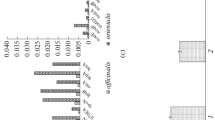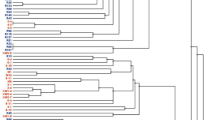Abstract
Comparative study of Rhizobium leguminosarum populations formed under the conditions of the Srednii Island (White Sea) demonstrated the introduced clover rhizobia (R. l. bv. trifolii) to be more variable than the aboriginal vetch/vetchling rhizobia (R. l. bv. viceae) in the chromosomal IGS locus, while being less variable in the plasmid-located symbiotic genes nodD and nifH. The analysis of these genes revealed the most pronounced differences between the clover and vetch/vetchling rhizobia populations. These differences, together with the results of ERIC-fingerprinting, indicated that the evolution of the clover rhizobia was mainly linked with the adaptation to local soil environment, and the evolution of the vetch/vetchling rhizobia, to the adaptation to various species of the host plants. High panmixia of R. leguminosarum population suggests its evolution to be based on the combinatory variability associated with the transfer of Sym-plasmids between R. l. bv. trifolii and R. l. bv. viceae, as well as with genomic rearrangements in the resulting recombinants.
Similar content being viewed by others
References
Bena, G., Lyet, A., Huguet, T., and Olivieri, I., Medicago-Sinorhizobium Symbiotic Specificity Evolution and the Geographic Expansion of Medicago, J. Evol. Biol., 2005, vol. 18, pp. 1547–1558.
Provorov, N.A. and Vorobyov, N.I., Evolution of Symbiotic Bacteria in “Plant-Soil” Systems: Interplay of Molecular and Population Mechanisms, in Progr. Environ. Microbiol., Kim, M.-B., Ed., New York: Nova Sci., 2008, pp. 11–67.
Laguerre, G., Lauvrier, P., Allard, M.R., and Amarger, N., Compatibility of Rhizobial Genotypes within Natural Populations of Rhizobium leguminosarum biovar viceae for Nodulation of Host Legumes, Appl. Environ. Microbiol., 2003, vol. 69, pp. 2276–2283.
Brom, S., Girard, L., Garcia-de los Santos, A., Sanjuan-Pinilla, J.M., Olivares, J., and Sanjuan, J., Conservation of Plasmid-Encoded Traits among Bean-Nodulating Rhizobium Species, Appl. Environ. Microbiol., 2002, vol. 68, pp. 2555–2561.
Sullivan, J.T., Trzebiatowski, J.R., Cruickshank, R.W., Gouzy, J., Brown, S.D., Elliot, R.M., Fleetwood, D.J., McCalum, N.G., Rossbach, U., Stuart, G.S., Weaver, J.E., Webby, R.J., de Bruijn, F., and Ronson, C., Comparative Sequence Analysis of the Symbiosis Island of Mesorhizobium loti Strain R7A, J. Bacteriol., 2002, vol. 184, pp. 3086–3095.
Nandasena, K.G., O’Hara, G.W., Tiwari, R.P., and Howieson, J.G., Rapid in situ Evolution of Nodulating Strains for Biserrula pelecinus L. through Lateral Transfer of a Symbiosis Island from the Original Mesorhizobial Inoculants, Appl. Environ. Microbiol., 2006, vol. 72, pp. 7365–7367.
Sanjuan, J., Herrera-Cervera, J.A., Sanjuan-Pinilla, J.M., Munoz, S., Nogales, J., and Olivares, J., Horizontal Gene Transfer in Rhizobia: Ecological Implications, in Nitrogen Fixation: From Molecules to Crop Productivity, Pedrosa, F., Ed., Dordrecht: Kluwer Acad., 2000, pp. 593–594.
Provorov, N.A. and Vorob’ev, N.I., Role of Horizontal Gene Transfer in the Evolution of Root Nodule Bacteria Directed by Host Plants, Usp. Sovrem. Biol., 2010, vol. 130, no. 4, pp. 336–345.
Dorosinskii, L.M., Metodicheskie rekomendatsii dlya kursov povysheniya kvalifikatsii nauchnykh sotrudnikov po sel’skokhozyaistvennoi mikrobiologii. Metody issledovanii kluben’kovykh bakterii (Recommendations for Researchers’ Extension Courses in Agricultural Microbiology. Methods for Investigation of Root Nodule Bacteria), Leningrad: VNIISKhM, 1981.
Laguerre, G., Mavingui, P., Allard, M.R., Charnay, M.P., Lauvrier, P., Mazurier, S.I., Rigottier-Gois, L., and Amarger, N., Typing of Rhizobia by PCR DNA Finge-printing and PCR-Restriction Lengths Polymorphism Analysis of Chromosomal and Symbiotic Gene Regions: Application to Rhizobium leguminosarum and Its Different Biovars, Appl. Environ. Microbiol., 1996, vol. 62, pp. 2029–2036.
Sambrook, J., Fritsch, E.F., and Maniatis, T., Molecular Cloning: A Laboratory Manual. 2nd ed., 1989, New York: Cold Spring Harbor Lab. Press.
Nei, M., Estimation of Average Heterozygosity and Genetic Distance from a Small Number of Individuals, Genetics, 1978, vol. 89, pp. 583–590.
Selander, R.K., Caugant, D.A., Ochman, H., Musser, J.M., Gilmour, M.N., and Whittam, T.S., Methods of Multilocus Enzyme Electrophoresis for Bacterial Population Genetics and Systematics, Appl. Environ. Microbiol., 1986, vol. 51, pp. 873–884.
Begon, M., Harper, J.L., and Townsend, C.R., Ecology. Individuals, Populations and Communities, Oxford: Blackwell, 1986, vol. 1.
Versalovic, J., Koeuth, T., and Lupski, J.R., Distribution of Repetitive DNA Sequences in Eubacteria and Application to Fingerprinting of Bacterial Genomes, Nucleic Acid Res., 1991, vol. 19, pp. 6823–6831.
Schlaman, H.R.M., Phillips, D.A., and Kondorosi, E., Genetic Organization and Transcriptional Regulation of Rhizobial Nodulation Genes, in The Rhizobiaceae. Molecular Biology of Model Plant-Associated Bacteria, Spaink, H.P., Kondorosi, A., and Hooykaas, P.J.J., Eds., Dordrecht: Kluwer, 1998, pp. 361–386.
Young, J.P.W., Crossman, L.C., Johnston, A.W.B., Thomson, N.R., Ghazoui, Z.F., Hull, K.H., Wexler, M., Curson, A.R.J., Todd, J.D., Poole, P.S., Mauchline, T.H., East, A.K., Quail, M.A., Churcher, C., Arrowsmith, C., Cherevach, I., Chillingworth, T., Clarke, K., Cronin, A., Davis, P., Fraser, A., Hance, Z., Hauser, H., Jagels, K., Moule, S., Mungall, K., Noebertczak, H., Rabbinowitsch, E., Sanders, M., Simmonds, M., Whitehead, S., and Parkhill, J., The Genome of Rhizobium leguminosarum Has Recognizable Core and Accessory Components, Genome Biol., 2006, vol. 7, pp. 34–41.
Wang, C.L., Beringer, J.E., and Hirsch, P.R., Host Plant Effects on Inter-Specific Hybrids of Rhizobium leguminosarum biovars viceae and trifolii, J. Gen. Microbiol., 1986, vol. 132, pp. 2063–2070.
Kaminski P., Batut J., and Boistard P., A Survey of Symbiotic Nitrogen Fixation by Rhizobia, in The Rhizobiaceae. Molecular Biology of Model Plant-Associated Bacteria, Spaink, H.P., Kondorosi, A., and Hooykaas, P.J.J., Eds., Dordrecht: Kluwer, 1998, pp. 431–460.
Provorov, N.A., Interaction between Leguminous Taxonomy and Specificity of Their Interaction with Root Nodule Bacteria, Bot. Zh., 1992, vol. 77, no. 8, pp. 21–32.
Lie, T.A., Göktan D., Engin M., Pijnenborg J., and Anlarsal E., Co-Evolution of the Legume-Rhizobium Association, Plant Soil, 1987, vol. 100, pp. 171–181.
Mutch, L.A. and Young, J.P.W., Diversity and Specificity of Rhizobium leguminosarum biovar viceae on Wild and Cultivated Legumes, Molec. Ecol., 2004, vol. 13, pp. 2435–2444.
MacLean, A.M., Finan, T.M., and Sadowsky, M.J., Genomes of Symbiotic Nitrogen-Fixing Bacteria of Legumes, Plant Physiol., 2007, vol. 144, pp. 615–622.
Eardly, B.D., Wang, F.-S., Whittam, T.S., and Selander, R.K., Species Limits in Rhizobium Populations That Nodulate the Common Bean (Phaseolus vulgaris), Appl. Environ. Microbiol., 1995, vol. 61, pp. 507–512.
Wernegreen, J.J., Harding, E.E., and Riley, M.A., Rhizobium Gone Native: Unexpected Plasmid Stability of Indigenous Rhizobium leguminosarum, Proc. Natl. Acad. Sci. U. S. A., 1997, vol. 94, pp. 5483–5488.
Kurchak, O.N., Provorov, N.A., and Simarov, B.V., Comparison of the Adaptive Potential for Rhizobium leguminosarum bv. viceae Nodule Bacterial Populations Isolated in Natural Ecosystems and Agrocenoses, Russ. J. Genet., 2011, vol. 47, no. 4, pp. 425–431.
Provorov, N.A. and Vorob’ev, N.I., Evolutionary Genetics of Nodule Bacteria: Molecular and Population Aspects, Russ. J. Genet., 2000, vol. 36, no. 12, pp. 1323–1335.
Author information
Authors and Affiliations
Corresponding author
Additional information
Original Russian Text © N.A. Provorov, E.E. Andronov, O.P. Onishchuk, O.N. Kurchak, E.P. Chizhevskaya, 2012, published in Mikrobiologiya, 2012, Vol. 81, No. 2, pp. 244–253.
Rights and permissions
About this article
Cite this article
Provorov, N.A., Andronov, E.E., Onishchuk, O.P. et al. Genetic structure of the introduced and local populations of Rhizobioum leguminosarum in plant-soil systems. Microbiology 81, 224–232 (2012). https://doi.org/10.1134/S0026261712020129
Received:
Published:
Issue Date:
DOI: https://doi.org/10.1134/S0026261712020129
Keywords
- genetic structure of a population
- horizontal gene transfer
- evolution of symbiosis
- root nodule bacteria of clover (Rhizobium leguminosarum bv. trifolii) and vetch/vetchling (R. l. bv. viceae)
- genes for nodulation (nod) and N2 fixation (nif)
- polymorphism of chromosomal and plasmid loci
- PCR analysis
- genomic fingerprinting




